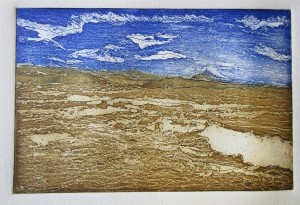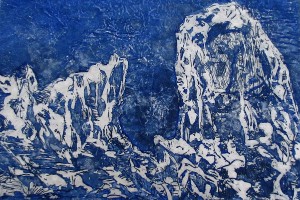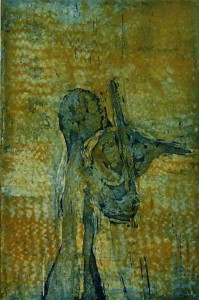The last two weeks have been a total immersion into learning several alternative techniques for etching copper and zinc plates using electrochemical processes. The electrolytic method is extremely effective for etching, offering varied ways to produce tones, textures, and lines.
On my previous blog entry I have listed the materials I was bringing with me. They all have been useful and I am glad I have them handy. However, Spain has www.grabadonline.com, an art supplier specializing in printmaking. Manuel and Rosalia expended a lot of effort to obtain very particular ingredients needed for making the graphite ground – a solvent made only in Germany – and are shipping it to Las Palmas with an extra list of supplies that I ‘had to have’. Indeed, I am very pleased with their very deep understanding of printmaking.
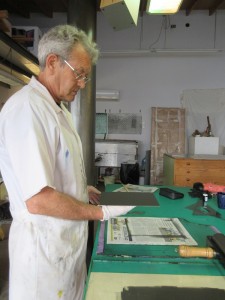 On electro-etching, I started the first week learning more about a variety of grounds. Graphite ground is a great favorite for its being a Ground_AlcoholSmgood electricity conductor. Lithographic pencils works surprisingly well to make interesting marks. I made “Puertilo” print (below) using litho pencils of different softness. Artools’ alcohol-based ink is the only stop-out that can be applied together with graphite ground, it dries fast and feels like painting with aquarels. Even contact plastic works well as a stop out and I used it during the Passive Etching method in combination with the other grounds. One of the advantages of using electricity for etching is that there are all these different grounds that can be safely applied to the plate that would not work as well if etching with ferric and/or nitrite acids.
On electro-etching, I started the first week learning more about a variety of grounds. Graphite ground is a great favorite for its being a Ground_AlcoholSmgood electricity conductor. Lithographic pencils works surprisingly well to make interesting marks. I made “Puertilo” print (below) using litho pencils of different softness. Artools’ alcohol-based ink is the only stop-out that can be applied together with graphite ground, it dries fast and feels like painting with aquarels. Even contact plastic works well as a stop out and I used it during the Passive Etching method in combination with the other grounds. One of the advantages of using electricity for etching is that there are all these different grounds that can be safely applied to the plate that would not work as well if etching with ferric and/or nitrite acids.
Here you can see Alfonso Crujera holding a plate with freshly applied graphite ground on. You can see samples of grounds: alcohol base Artools (right top) and plastic contact used as stop-out (below left) to make the relief plate (below right) using the passive electro-etching technique.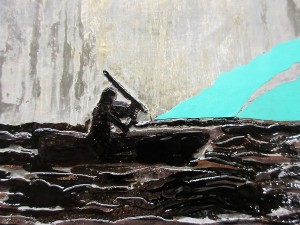
Learning the Passive Etching and Semi-Dry Etching techniques are definitely the two highlights of the residency experience up to date. Passive Electro-Etching produces deep relief prints, carving into the zinc plate multiple levels to create tonal and relief effects. The zinc plate in the copper sulphate solution has to be prepared with a copper hanger on the back. If a zinc hangers with zinc plate are used it will fast corrode the plate, even make a hole in the plate!
Semi-Dry electro-etching is made on a flat tray using two plates of the same metal. A felt cloth wet with the matching salt solution (copper or zinc sulphate) is placed between the plates (cathode and anode) to close the circuit. Semi-Dry etching transforms plate’s surface creating an only partially controlled array of textures. Semi-dry electro-etching is simple to assemble, it does not take much space in the studio and produces strong etched plates, it feels like a jewelry, competing interest to the print in itself.
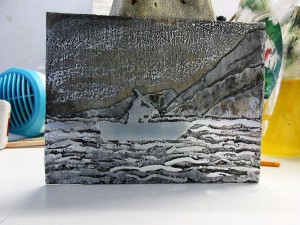
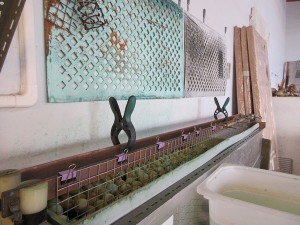
At the moment I am learning Galvanization, the process in which the polarity is inverted, placing the negative pole on the plate which will then receive metal to create a embossed/relief line instead of an etched fixture to hold the ink. The vertical tank (left) has two separate compartments, one filled with copper sulphate for etching copper plates, and the other filled with zinc sulphate for etching zinc plates.
Working in the studio 10 to 12 hours a day does not give me much time to go snorkeling even though there are a few natural pools close by. Yet, it has been useful to have my water boots and diving mask with me. But, next time I come to the Canaries I will definitely bring my hiking poles. Gran Canaria is a paradise for hill walking with its mountains, forests and inhabited cave villages. Hiking has been the most enjoyable sport activity during my stay in the residency. Gwyn (below) is the mascot of the Alfonso Crujera and his wife Amparo’s hiking group.
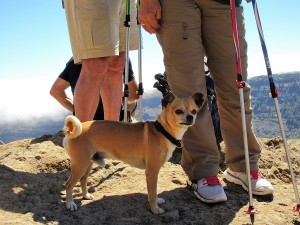
These are some of the first proofs: “Puertilo” made with lithographic pencils (top left); “Roque Nublo” etched on a flat tray using the semi-dry process (top right); “Sonata #19” and “Sonata # 32” (bottom) both plates had graphite ground as stop-outs, “Alfonsina El Mar” detail of the embossing made through the a Passive Etching method.
